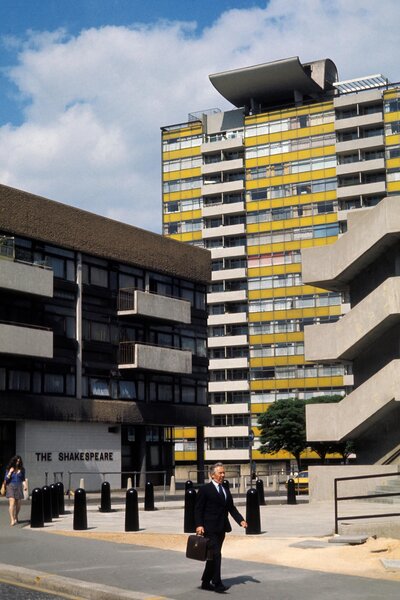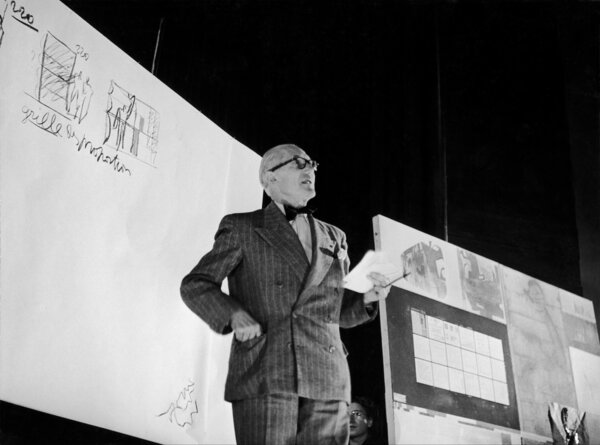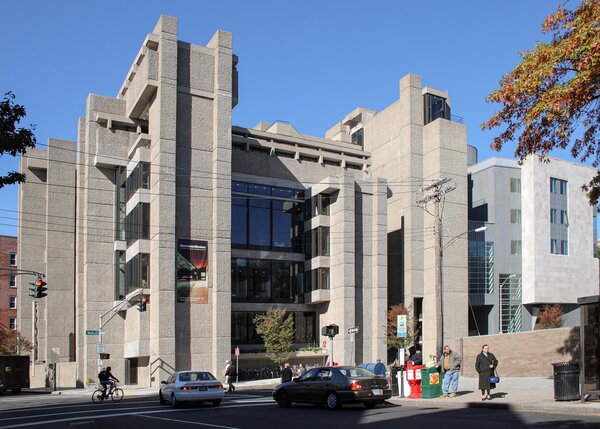The concrete history of modern architecture’s most polarizing style.
This story is part of Pretty Ugly, a package celebrating design that’s so bad, it’s good.
Love it or hate it: Brutalist architecture is hard to ignore. You’ll find it around the world—from the famed Barbican Centre in London to the Yale Art and Architecture Building in New Haven, Connecticut. These are buildings that command attention, and hark back to a midcentury movement that isn’t remembered for its subtlety.

The Barbican Center in London
Photo by Michael SERRAILLIER/Gamma-Rapho via Getty Images
Indeed, while the term brutalism is derived from the French phrases béton brut (raw concrete) and art brut ("raw art"), the style is championed—and chided—for its massive lines, its undecorated facades, and, yes, its arguably brutal and blunt approach to geometry and form. Brutalist buildings are buildings with presence—they feel massive, and almost foreboding. But with a fresh perspective, they’re buildings that can be loved, as well.
"The word brutalism is often used—particularly by people who say they hate it—to describe buildings that are clearly made out of concrete; and buildings that appear ungainly in some way, or even abrasive," explains architectural historian Tom Wilkinson. He adds, "That is a fairly accurate description of what brutalism is, but it’s not just that."
The Birth of Brutalism

A 1953 portrait of Le Corbusier in Milan
Photo by Keystone-France/Gamma-Keystone via Getty Images
To understand brutalism, Wilkinson says you need to revisit the architecture of the early- to mid-20th century, and the work of renowned Swiss-French architect Le Corbusier. To some, Le Corbusier is best known for the modernist villas he designed throughout the 1920s and into the 1930s, like Villa Savoye in France, Corbusier Haus in Stuttgart and Villa La Roche-Jeanneret, which now houses the Fondation Le Corbusier in Paris. He worked within "purism," a visual language that was at once sculptural and pared down: whitewashed walls, simple lines, and the same absence of decoration for which brutalism is now known.
Elements of Le Corbusier’s purism descended into the Unité d’Habitation, a residential typology that the architect first developed and implemented in a high-density housing complex in Marseille. Built between 1947 and 1952, this was the first, and arguably most famous, Unité—and it is commonly regarded as the starting point for brutalism, both in form and in philosophy. (The typology was later used to create four additional buildings, including ones in Paris and Berlin.)
Concrete Details

The Art and Architecture Building at Yale University
Photo by Sage Ross, licensed under GFDL and Creative Commons CC-BY-SA-2.5
See the full story on Dwell.com: Why You Either Love or Hate Brutalism
Related stories:
- An Architect Scrapes Away Decades of Paint to Polish Up a Brutalist Gem
- A Pair of Hang Gliders Imagine a Home From a Bird’s-Eye View
- 23 Beautifully Textured Board-Formed Concrete Homes
Read More
By: Nathan Ma
Title: Why You Either Love or Hate Brutalism
Sourced From: www.dwell.com/article/why-you-either-love-or-hate-brutalism-8ee0a9d3
Published Date: Wed, 01 Feb 2023 01:21:26 GMT
.png)





